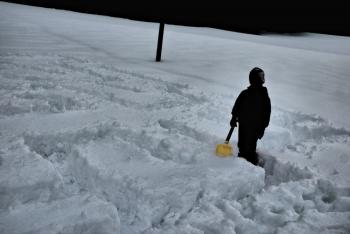

We're delighted to announce the addition of Book Scrounger to our site. To scrounge, according to one dictionary, means "to actively seek money, work, or sustenance from any available source." Into this definition, insert the word "books" in place of "money, work, or sustenance," and you have Book Scrounger's definition of what she does: she actively seeks books from any available source.
In part, she does this for the benefit of her children, so you will find write-ups of many picture books, as well as history, science, and art books written for children. Her children are currently pre-school and kindergarten age, so the blog is currently "heavy" on that age level. Of course, over time, that will change.
In part, she scrounges books for her own pleasure, as she is an insatiable reader, and her bedside table is stacked so high with books in her to-read list that it will take her ten years to get through them all. Except...she keeps adding to the stack, so she may never finish them all. So in addition to finding books for children, you may occasionally find a more "grown-up" book.
In additional to all this, she occasionally permits her husband (the infamous Professor Puzzler of the "Ask Professor Puzzler" blog) to write a blog post.
Do you aspire to being a book scrounger too? If you wish you could have a "to-read" stack as tall as the Book Scrounger's stack, but you don't know how to get started with your scrounging habit, check out this handy list of suggestions the Book Scrounger has written: Book Scrounging Tips.
Note: If you're wondering why a "new" blog has posts dated back several years, the reason is simple: the older posts used to be part of our "Product Reviews" blog. These have been shifted over to the new blog, in order to keep all book reviews together.
In the aftermath of Hurricane Harvey, there are currently three more hurricanes in the Atlantic: Hurricanes Irma, Jose, and Katia. All three are concerning in one way or another, but Hurricane Irma has developed into one of the most powerful hurricanes on record. It is currently wreaking havoc in the Caribbean, and is headed in the direction of Florida.
As educators, we should be aware of these events going on in the world, and ready to talk to our students in compassionate and intelligent ways about them. My own students (I teach high school math at a small private academy) want to know what are the possible outcomes of these storms, what are the dangers involved, and who will be effected. Even though we live far from "hurricane country" (the last time a hurricane did any serious damage in our state was before my students were born), being part of a wider community means being both concerned and compassionate about the effects of these natural disasters.
Talking about the hurricanes, and the potential tragedies that may occur as a result of their passing, should be done in an age appropriate fashion. At the high school level, I used some math related questions as a launching point to spend a few minutes talking to my students about natural disasters. The students saw real-world application of mathematics, and had the opportunity to somberly reflect on what that mathematics meant from the perspective of humanity in the path of the hurricane.
If you would like to take a look at some of the discussion that took place in my math classes, you can visit the following links:
Under the Hurricane
Response to a question I received from a resident of Florida, who wanted to know how long she could expect her house to be "under" the hurricane. I used this question as a problem-solving exercise with my upper level math classes.
Waiting for the Hurricane
A write-up of a slightly more complex math question that I worked through with my students. The problem is to identify how long it will be before the hurricane reaches a specific point.
Hurricane Conspiracies
Professor Puzzler gets irate about the conspiracy theories and "fake news" floating around regarding hurricanes.
Tell Us about Your Lesson Plans
Have you done specific hurricane-themed lessons that you would like to share with others? You can send us a lesson plan. If we publish your lesson, we'll reward you with a ProMembership on this site!

In 2002, we launched two major websites: The Problem Site, and Articles for Educators. These two sites were both educational in nature, but had very different focuses. The Problem Site was geared toward students, with math problems and educational games. Articles for Educators was geared toward teachers, with lesson plans and research topics in the field of education.
As time has gone on, the focus of The Problem Site has broadened, and we've provided more and more resources for teachers, such as printable worksheets, reference units, the virtual classroom, and other features. In recent months we've come to recognize that there is no longer need to maintain two separate websites, as the content of Articles For Educators fits within the scope of this site.
Accordingly, we've been working to transfer the content from AFE over to TPS, and at the same time we've developed more robust features for that content; now teachers who use the "Lesson Plans" section of this site can create not just lesson plans, but also slide shows, worksheets, and answer keys. The new version of AFE can be found here: Lesson Plans.
As an example, I just added a lesson plan that I used in my high school Physics class last week. This lesson plan contains instructions for the teacher, a short slide show, and a couple handouts teachers can use. The lesson is: Blue Whales Eating Krill.
You can also integrate lesson plans with "Pro Problems" on the site; set up a slide show that contains selected pro problems for your students. Here's an example: Systems - Word Problems.
I hope you enjoy the updated appearance and easier "Print" capabilities of the new Articles for Educators, as well as the way it integrates with The Problem Site.
On a completely different subject, I would like to wrap up with an apology; The Problem Site had a bit of downtime overnight as we migrated the entire system to a new server. The process took about 1.5 hours 3:00 AM to 4:30 AM (EST). The process was intended to happen over the weekend while schools were not in session, but due to circumstances beyond our control, the process was initiated overnight this morning.
We understand that may have produced inconvenience for our schools in China, India, and throughout Europe, and I apologize for that inconvenience. The new server is faster and more robust, and we do not anticipate any more downtime in the near future.

Recently we've had a few printable mazes added to the site. Mostly these are related to upcoming holidays. There are a couple mazes related to Martin Luther King Jr. Day, some new president mazes for Presidents' Day, several new Valentine's Day mazes, and a couple new St. Patrick's Day mazes as well.
For a full directory of all the mazes on the site, go here: Printable Maze Directory.
If you're a pro-member, you can also create your own mazes for special occasions, or just for fun!
On the other hand, in case you're the sort of person who would rather be out enjoying the snow, here's another idea for you: make a maze in the snow! It's actually easier than you might think, and you just need to follow some simple rules to create your own snow maze.
Here's a picture of a snow maze I made for my son and I to play in this afternoon. Click the image to get a larger view.

- Your entire maze will be one single, connected path with many forks in it. Once you've started a path, you can turn, you can fork, but you should never leap out of your path to start a new, disconnected path.
- When you want to create a fork, backtrack along your path and select a fork point, and walk in a new direction. The repeated backtracking will also help pack your path down.
- Make sure you have several forks that go a good distance; if all the forks are very short, it will be obvious to the maze solver that it goes nowhere.
- Forks should always go out from a path, but never reconnect to the path at the other end. In other words, every fork is eventually a dead end.
Once the maze is made, pick one of the dead ends as the ending point of the maze, and stand at that endpoint. Tell the solver where the starting point is, and let them try to get to you without stepping out of the path.
The beauty of this is, for every fork you made, there's an endpoint, and every endpoint can be a place for you to stand. Every time you move to a new endpoint, you've created a whole new maze for the solver, just by standing in a different place.
My son and I had a blast with this maze.
When you're done, come on inside, make some hot chocolate, and print off a maze to try together on paper!


